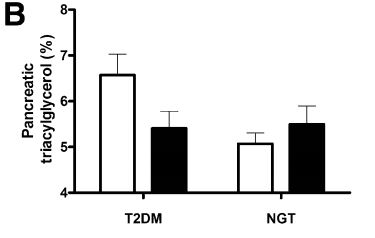Maybe!
The summary comes from this article, which paints a slightly different picture, but important nonetheless.
So what is going on?
Well, it is part truth and part sensational, attention-grabbing headlines.
Gastric Bypass, Insulin sensitivity and Type 2 Diabetes
In the actual study, the authors evaluated both type 2 diabetics and non-diabetics, matched for age, sex and weight, before and 8 weeks after gastric bypass surgery (laproscopic RYGB).
The results were interesting.
Both groups lost weight after surgery (not surprising) and both groups lost a significant amount of body fat (also not surprising). However, the type 2 diabetic group also lost a significant amount of pancreatic fat, which did not happen in the non-diabetic group. See figure below.

This led to significant improvements in all measures of insulin sensitivity for the type 2 diabetic group, which means a significant improvement in controlling type 2 diabetes. In other words, they improved.
It’s also likely why the authors of the summary had such a sensational headline.
Can you spot reduce visceral fat?
So what happened here?
The type 2 diabetic group had a higher level of pancreatic fat before surgery. This is internal fat, known as visceral fat. Subcutaneous fat is the fat right underneath your skin. It’s the fat you can pinch. Studies have repeatedly shown that visceral fat is more detrimental to your health than subcutaneous fat.
If you are type 2 diabetic, you might wonder if you can specifically reduce visceral fat and improve your insulin sensitivity. And based on the questions I’ve had, many of you are wondering this.
The answer is kind of.
You can do this through diet and exercise and probably by sleeping better and managing stress.
We will focus on exercise and diet.
Exercise, Type 2 Diabetics and Visceral Fat
Higher intensity exercise has repeatedly been shown to decrease visceral fat, whether type 2 diabetic or not. And, while both low and high-intensity exercise have been shown to also reduce subcutaneous fat, it is high intensity exercise that can do so more preferentially.
Given that the type 2 diabetics had higher amounts of visceral fat at the beginning of the study, exercise might be a plausible explanation for the significant reduction in pancreatic fat after surgery. It’s unlikely, though, since surgery can be rough and assessment was only 8 weeks after surgery.
Diet, Type 2 Diabetics and Visceral Fat
It is likely the significantly reduced caloric intake after surgery was the main reason for reduction in pancreatic fat. Prior to the surgery, the average weight of the type 2 diabetics was 266 pounds. Eight weeks after surgery it was 230 pounds. This is an average weight loss of 36 pounds or 4.5 pounds per week. And…of those 36 pounds of weight loss, 30 of them were fat, which means they were losing 3.75 pounds of fat per week.
To lose 4.5 pounds per week, you need a daily caloric deficit of 2,250 calories per day (going by the 3,500 calories per pound, which is questionable). That’s a HUGE caloric deficit!
Which brings us back to diet and visceral fat. A caloric deficit this large will lead to significant visceral fat reduction. And without surgery, I’m not sure anyone can subject themselves to a caloric deficit of this magnitude.
Outside of gastric bypass surgery, what can you do, at least nutritionally, to decrease visceral fat? The research is fairly clear on this. A diet that severely limits processed foods – particularly processed carbohydrates will help. A low-carb, high-fat diet (which may be the same thing) will also do the trick.
But it won’t work as fast as surgery.
So what does is all mean?
Well, the diabetes wasn’t reversed in this population but it was significantly improved. And it corresponded to a decrease in pancreatic fat. This most likely happened because of a massive reduction in caloric intake after gastric bypass surgery.
Outside of surgery, are there things you can do to preferentially target pancreatic or visceral fat? Yes!
If you are a type 2 diabetic you should consider two things: 1) a diet lower in processed carbohydrates and 2) work to improve your fitness level. Diets lower in processed carbohydrates (or low-carb, high-fat diets) have repeatedly been shown to reduce visceral fat (and subcutaneous fat too). Improving your fitness level through any means of physical activity so that you can perform higher intensity activity is also important. And at some point, you probably need to make sure you are getting enough sleep and managing stress.
These two things will accomplish the same as the surgery, just not as quickly or severe.


